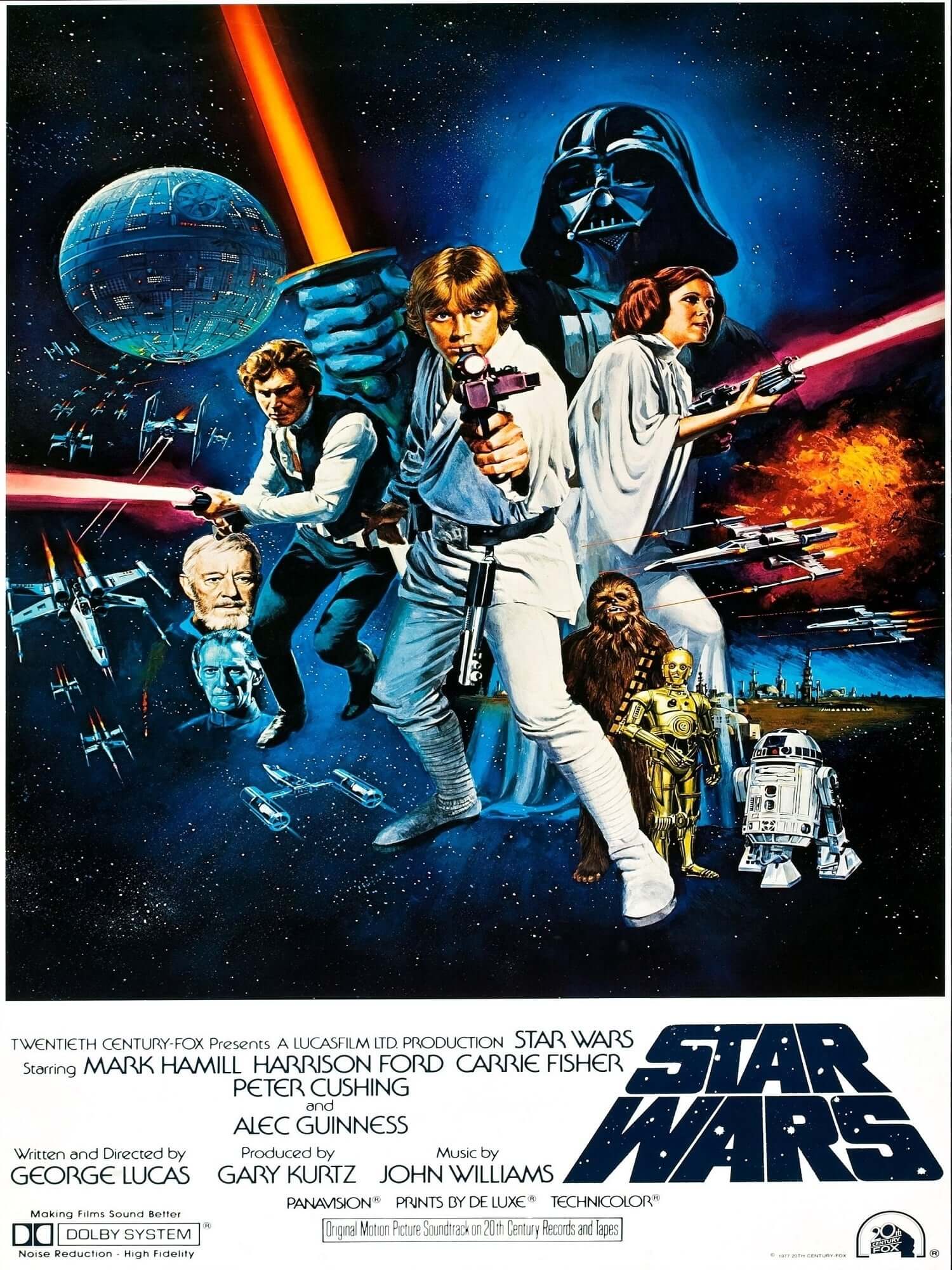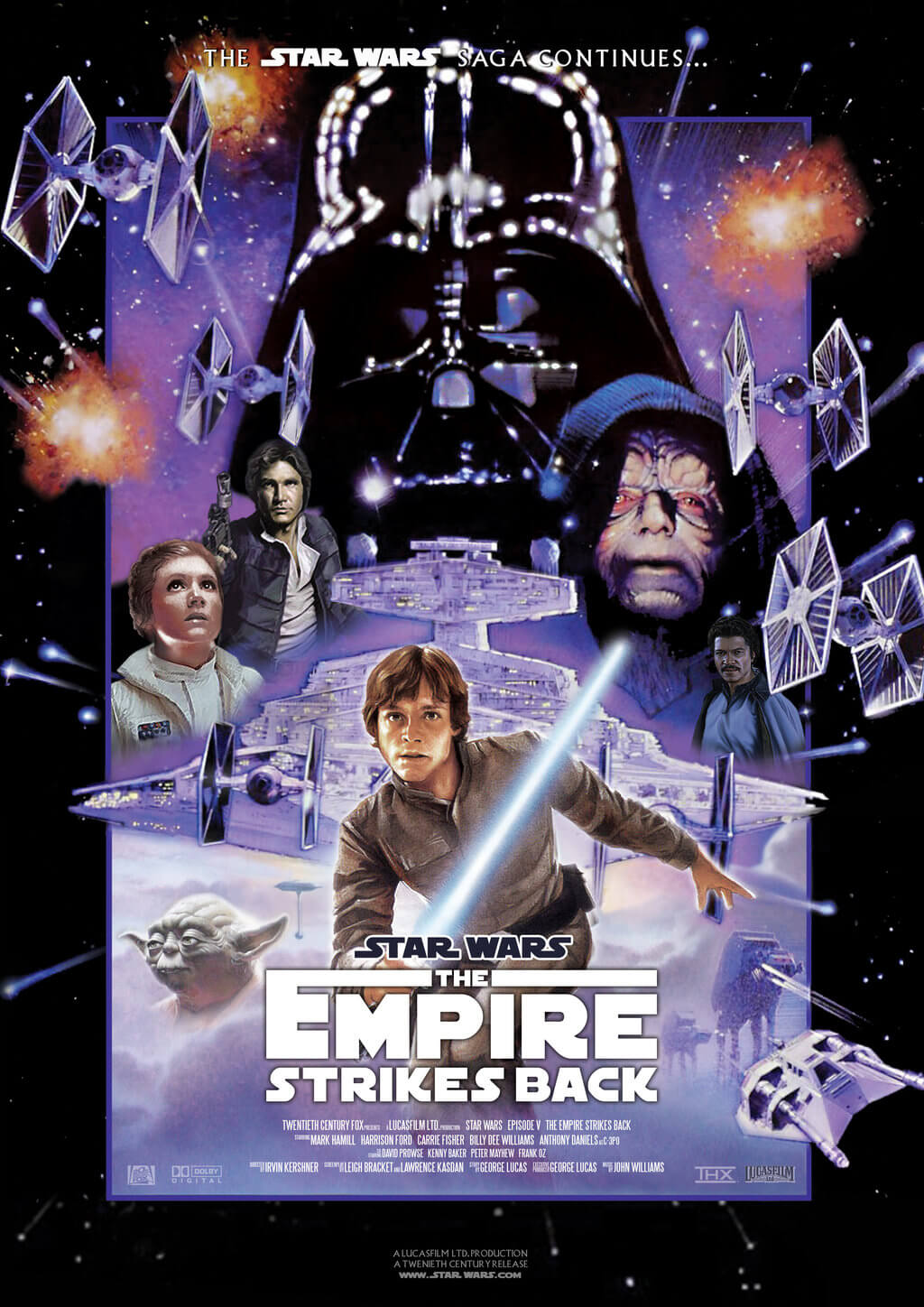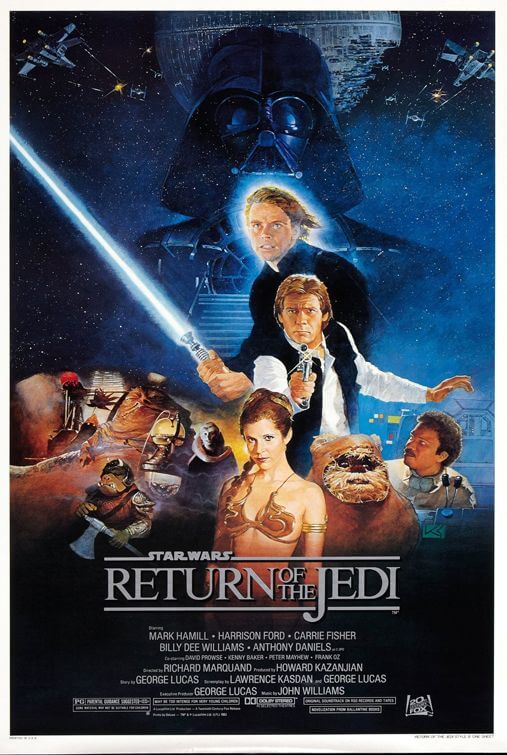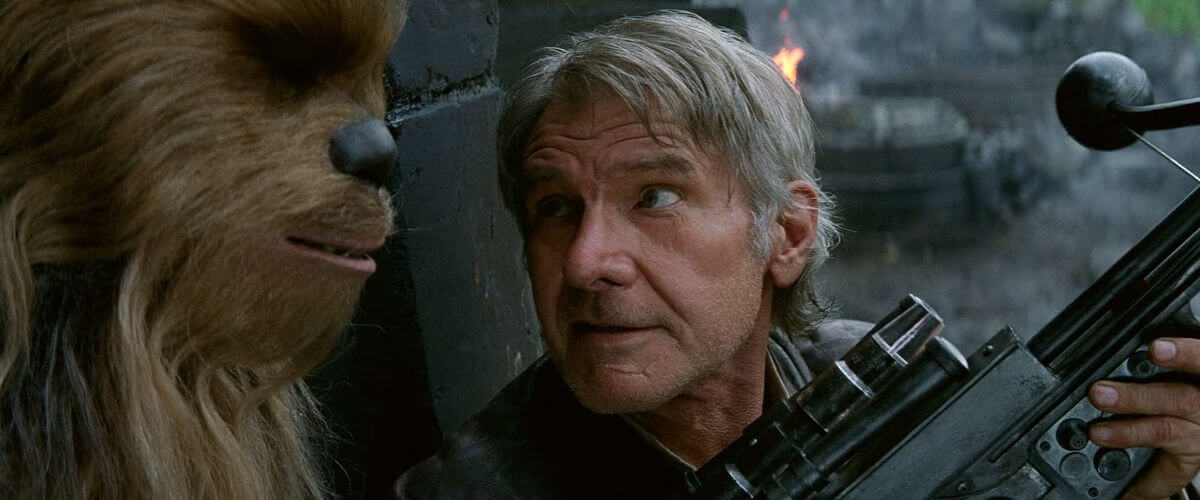
Star Wars: Episode VII – The Force Awakens
By Brian Eggert |
George Lucas’ original Star Wars debuted in 1977 and redefined Hollywood cinema. Since then, Lucas has released more bad sequels than good, sold billions in merchandising, and established a mythos that reaches into nearly every facet of our society. More than 33 years later, Star Wars: Episode VII – The Force Awakens returns us to well-treaded territory that, structurally anyway, bears a close resemblance to the original, A New Hope. Director J.J. Abrams delivers an exciting first entry in a new trilogy, and also a very often exceptionally well-made new film, that will satisfy fans new and old. It even helps us forget about the franchise’s missteps over the years. After all, Lucas’ subsequent prequels demystified the magic of the original films and concentrated on boring political machinations and mindless, computer-animated action sequences. But The Force Awakens returns Star Wars to an involving space adventure on par with the original, in both spirit and story.
After Lucas sold Disney the rights to Star Wars and Lucasfilm in 2012, the mega-studio announced plans for another trilogy. How could they resist? Then again, Lucas had originally envisioned three trilogies. After Star Wars debuted in 1977 and became a huge success, Lucas revealed to several interviewers his plans for a nine-film saga, complete with three individual trilogies. The first would involve Luke Skywalker and Darth Vader; a prequel trilogy would follow a young Obi-Wan and Anakin Skywalker; a final trilogy would be about eliminating the Dark Side, represented by the Emperor. Although his initial plan was meant to be completed by the year 2000, his grand design quickly changed. Before The Empire Strikes Back completed filming, Lucas was already burnt out on the whole concept of Star Wars; it had kept him away from his family and eventually led to his divorce. And so, he resolved to finish the third trilogy’s Emperor story arc in Return of the Jedi and considered his saga complete, aside from the potential for prequels—and not until more than a decade later did Lucas produce his much-despised prequel trilogy.
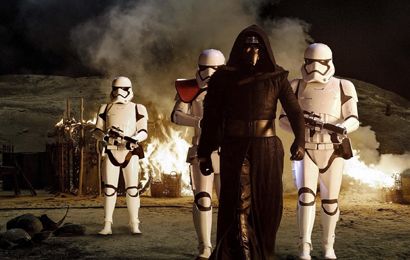 Since the early 1970s, when Lucas first conceived a galaxy born from Flash Gordon and Akira Kurosawa, the filmmaker has been involved in the production of every sequel in his ongoing saga. When Disney announced a new trilogy and several spinoffs in 2013, Lucas agreed to step aside, apart from hand-picking the first film’s director: Abrams, who admitted his lifelong love of Star Wars when he was making 2009’s Star Trek. Along with Lawrence Kasdan (writer of The Empire Strikes Back and Raiders of the Lost Ark), Abrams rewrote an initial draft of the script by Michael Arndt (Toy Story 3) and shaped new characters, locations, and scenarios. Also, fully aware of incensed fan reactions to the prequel trilogy, Abrams sought to recreate the formal splendor of the original trilogy. His cinematographer Dan Mindel shoots on 35mm film stock, as opposed to the digital camerawork employed on Lucas’ prequels; Abrams’ production designers Rick Carter and Darren Gilford use tactile sets instead of greenscreen work whenever possible; costume designer Michael Kaplan captures the dilapidated look of the original trilogy; and special effects supervisor Chris Corbould uses mostly practical FX over CGI in both characters and backdrops.
Since the early 1970s, when Lucas first conceived a galaxy born from Flash Gordon and Akira Kurosawa, the filmmaker has been involved in the production of every sequel in his ongoing saga. When Disney announced a new trilogy and several spinoffs in 2013, Lucas agreed to step aside, apart from hand-picking the first film’s director: Abrams, who admitted his lifelong love of Star Wars when he was making 2009’s Star Trek. Along with Lawrence Kasdan (writer of The Empire Strikes Back and Raiders of the Lost Ark), Abrams rewrote an initial draft of the script by Michael Arndt (Toy Story 3) and shaped new characters, locations, and scenarios. Also, fully aware of incensed fan reactions to the prequel trilogy, Abrams sought to recreate the formal splendor of the original trilogy. His cinematographer Dan Mindel shoots on 35mm film stock, as opposed to the digital camerawork employed on Lucas’ prequels; Abrams’ production designers Rick Carter and Darren Gilford use tactile sets instead of greenscreen work whenever possible; costume designer Michael Kaplan captures the dilapidated look of the original trilogy; and special effects supervisor Chris Corbould uses mostly practical FX over CGI in both characters and backdrops.
The result certainly looks and feels like it takes place in the same galaxy as the original trilogy, which is a relief. On a purely superficial level, characters, spaceships, and locations all remind us more of the originals than the prequels (helping us to forget those abysmal later entries ever existed). Familiar faces such as Harrison Ford’s Han Solo, Carrie Fisher’s Leia, Peter Mayhew under his shaggy Chewbacca costume, Anthony Daniels in the shiny C3PO getup, and R2D2 are each warmly received. But it’s the storytelling style of the first two films that Abrams and Kasdan have most effectively channeled—that effervescent vitality of the original two blockbusters. Abrams and Kasdan seek to replicate the energy of A New Hope and emotion of The Empire Strikes Back, while also laying the groundwork for a new trilogy. Even so, despite the twists and turns along the way, the story’s structure closely follows that of A New Hope to a fault, as though the filmmakers wanted to, in a way, remake that film for a new generation.
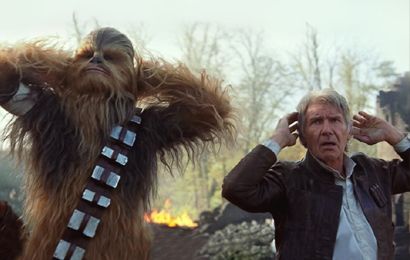 The Force Awakens begins some thirty years after the events in Return of the Jedi. Luke Skywalker has disappeared after a failed attempt to train a new flock of Jedi knights. In his absence, a new evil faction called the First Order has appeared, led by Supreme Leader Snoke (Andy Serkis, behind motion-capture animation). Snoke remains a shadowy figure who pulls the strings on General Hux (Domhnall Gleeson, channeling Adolf Hitler) and the conflicted, Vader-masked Jedi named Kylo Ren (Adam Driver), who call their headquarters a planetary weapon known as Starkiller Base. For reasons left somewhat unexplained, the First Order wants to obliterate Luke Skywalker. Meanwhile, a group known as the Resistance, led by General Leia, seeks out Luke as well. Leia has sent her top pilot, Poe Dameron (Oscar Isaac), to gather a map that leads to Luke, but he’s soon captured by the First Order on the desert planet Jakku. Just before this happens, Poe hides the map inside his droid, the lovable ball BB-8 (the roundest name for any robot). The droid soon partners with a friendly Jakku scavenger, Rey (Daisy Ridley, excellent), for safety.
The Force Awakens begins some thirty years after the events in Return of the Jedi. Luke Skywalker has disappeared after a failed attempt to train a new flock of Jedi knights. In his absence, a new evil faction called the First Order has appeared, led by Supreme Leader Snoke (Andy Serkis, behind motion-capture animation). Snoke remains a shadowy figure who pulls the strings on General Hux (Domhnall Gleeson, channeling Adolf Hitler) and the conflicted, Vader-masked Jedi named Kylo Ren (Adam Driver), who call their headquarters a planetary weapon known as Starkiller Base. For reasons left somewhat unexplained, the First Order wants to obliterate Luke Skywalker. Meanwhile, a group known as the Resistance, led by General Leia, seeks out Luke as well. Leia has sent her top pilot, Poe Dameron (Oscar Isaac), to gather a map that leads to Luke, but he’s soon captured by the First Order on the desert planet Jakku. Just before this happens, Poe hides the map inside his droid, the lovable ball BB-8 (the roundest name for any robot). The droid soon partners with a friendly Jakku scavenger, Rey (Daisy Ridley, excellent), for safety.
At the same time, one of General Hux’s nameless stormtroopers (John Boyega) questions his duties when he witnesses the First Order’s brutality. He vows to quit and escape but needs Poe, who gives him the name Finn, to help. Once free, they crash land on Jakku. Poe goes missing, but Finn meets Rey and BB-8. Knowing the First Order is after what’s inside BB-8, Finn helps Rey and BB-8 escape the planet on a spaceship recognized as the Millennium Falcon. Or maybe it’s Rey that helps Finn—she’s able to fight, pilot the ship, and generally make the best of any situation, and she’s hardly in need of rescuing. It’s the quality that Han and Chewbacca admire in Rey when they capture the Millennium Falcon with Finn and Rey inside. Han takes them to a pirate named Maz Kanata (Lupita Nyong’o), a seer who helps Finn realize he can’t run from the First Order anymore, Rey realize the Force is strong with her, and everyone realize the map inside BB-8 isn’t complete. All at once, the First Order attacks, captures Rey, while the Resistance, led by the miraculously alive Poe, swoops in to rescue the survivors.
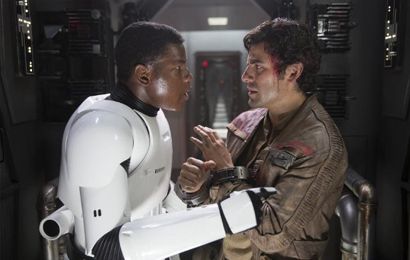 Han has avoided reuniting with the Resistance, as he and Leia had a son who in turn became the corrupted Kylo Ren. Determined to recover their son, Han and Leia plan an attack on Starkiller Base after the First Order destroys several planets housing the galactic Republic (perhaps Abrams’ way of destroying ties to the prequel trilogy). Finn offers his knowledge of the installation to help destroy it, but he’s less interested in helping the Resistance than rescuing Rey, who gradually discovers her Jedi powers that help her escape captivity. The finale follows Poe leading a dogfight to destroy Starkiller Base, while Han, Chewbacca, and Finn penetrate the base to rescue Rey and plant charges that will bring down the shields. The grounded showdown where Han confronts his son is among the most emotional scenes in all of the Star Wars saga, perhaps even outshining when Vader revealed his parentage to Luke. It’s a confrontation that ends in Kylo Ren killing his father in a fit of conflicted rage, a gasp-worthy moment to be sure—especially because Han has such a central role in this film, and because Ford makes a brilliant return to the character. Though Finn tries to take on the villainous Kylo Ren by himself and narrowly survives, Rey wins a duel that leaves Han’s son scarred, but alive. The final scenes mourn the beloved Han, and send Rey in search of Luke Skywalker to advance her manipulation of the Force.
Han has avoided reuniting with the Resistance, as he and Leia had a son who in turn became the corrupted Kylo Ren. Determined to recover their son, Han and Leia plan an attack on Starkiller Base after the First Order destroys several planets housing the galactic Republic (perhaps Abrams’ way of destroying ties to the prequel trilogy). Finn offers his knowledge of the installation to help destroy it, but he’s less interested in helping the Resistance than rescuing Rey, who gradually discovers her Jedi powers that help her escape captivity. The finale follows Poe leading a dogfight to destroy Starkiller Base, while Han, Chewbacca, and Finn penetrate the base to rescue Rey and plant charges that will bring down the shields. The grounded showdown where Han confronts his son is among the most emotional scenes in all of the Star Wars saga, perhaps even outshining when Vader revealed his parentage to Luke. It’s a confrontation that ends in Kylo Ren killing his father in a fit of conflicted rage, a gasp-worthy moment to be sure—especially because Han has such a central role in this film, and because Ford makes a brilliant return to the character. Though Finn tries to take on the villainous Kylo Ren by himself and narrowly survives, Rey wins a duel that leaves Han’s son scarred, but alive. The final scenes mourn the beloved Han, and send Rey in search of Luke Skywalker to advance her manipulation of the Force.
The lively chemistry between Rey and Finn is downright magnificent, Rey with her humanness and Finn with his enthusiastic everyman heroism—like a drone who’s suddenly been injected with life. They’re clearly stand-ins for the younger Luke Skywalker and Han Solo, but Ridley and Boyega are sparkling new additions to Star Wars lore. Most impressive is Driver, whose fiery inner conflict in a few brief scenes contains more emotional pull than Hayden Christiansen’s entire performance as the troubled Anakin Skywalker. The actors deserve credit for bringing these exciting new characters to life, but it’s the writers who’ve given The Force Awakens an emotional and meaningful drive. Abrams and Kasdan energize the material with fun new characters and exciting situations. We instantly care about Rey and Finn because their characters live and breathe with relatable emotion that was lacking in the prequels, and which drove the original trilogy. Given the considerable emotional pull of the story, all other minor flaws can be easily overlooked.
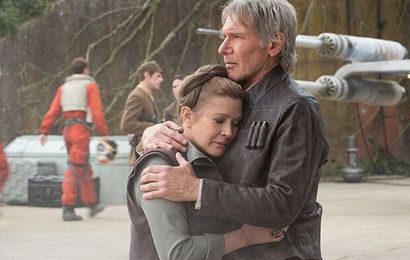 Indeed, this is not a perfect film. For example, the technical presentation is top-notch throughout most of The Force Awakens, but the CGIimagery used to create Snoke’s towering hologram recalls the bad animation of aliens in Indiana Jones and the Kingdom of the Crystal Skull. Snoke is perhaps the most underwhelming new addition, as he’s apparently been around for centuries but we’re not hearing about him until now. And then there’s how, structurally, The Force Awakens borrows much from A New Hope: the droid who carries a secret message wanted by the light and dark sides of the Force (R2-D2/BB-8); the young adventurer who will soon become a Jedi (Luke/Rey); the masked villain in black (Vader/Kylo Ren) who reports to a military leader (Tarkin/Hux), who in turn reports to a shrouded, mysterious, and powerful figure (Emperor/Snoke); the planet-sized weapon that can destroy whole worlds (Death Star/Starkiller Base); the rescue attempts aboard a deadly base, which has shields that must be brought down to destroy it; the bar filled with a plethora of alien types; the dogfight that leads to the destruction of the planetary weapon. It’s all very familiar stuff, with several direct parallels to the blueprint of A New Hope. But none of that matters much, as Abrams and Kasdan make it all so enjoyable.
Indeed, this is not a perfect film. For example, the technical presentation is top-notch throughout most of The Force Awakens, but the CGIimagery used to create Snoke’s towering hologram recalls the bad animation of aliens in Indiana Jones and the Kingdom of the Crystal Skull. Snoke is perhaps the most underwhelming new addition, as he’s apparently been around for centuries but we’re not hearing about him until now. And then there’s how, structurally, The Force Awakens borrows much from A New Hope: the droid who carries a secret message wanted by the light and dark sides of the Force (R2-D2/BB-8); the young adventurer who will soon become a Jedi (Luke/Rey); the masked villain in black (Vader/Kylo Ren) who reports to a military leader (Tarkin/Hux), who in turn reports to a shrouded, mysterious, and powerful figure (Emperor/Snoke); the planet-sized weapon that can destroy whole worlds (Death Star/Starkiller Base); the rescue attempts aboard a deadly base, which has shields that must be brought down to destroy it; the bar filled with a plethora of alien types; the dogfight that leads to the destruction of the planetary weapon. It’s all very familiar stuff, with several direct parallels to the blueprint of A New Hope. But none of that matters much, as Abrams and Kasdan make it all so enjoyable.
The most troublesome elements of The Force Awakens occur off-screen. If you’re an average moviegoer, the blatant commercialism of Star Wars probably just comes with the territory. Maybe you don’t even notice it. But Disney has taken it to an extreme degree to promote The Force Awakens. Though many of the film’s secrets have been effectively preserved by Abrams’ standard top-secret production, much of the audience will enter the film with a strange foreknowledge of the new characters’ names and faces thanks to marketing efforts—or possibly even some insight about the plot twists thanks to the saturated promotional material. Disney has even threatened to remove their über-successful film from theater chains like Arclight Theaters unless the competition (namely The Hateful Eight) is taken down from the Cinerama auditorium. The hype machine has been running on overdrive. Toys have been on shelves for months prior to the film’s release. Star Wars videogames and books have teased the film. Every store or chain restaurant you visit features a cross-promotion. The commercialism and exceptionalism of it all is enough to make a person sick. And audiences have years of near constant Star Wars publicity left to go, since Disney plans to release a new film every year through 2020. Not that most people mind. They just want more Star Wars. But I digress.
But if you can set all of that aside, you have a good movie. It’s not lightning in a bottle as A New Hope was, nor a completely new take on the characters as The Empire Strikes Back was. Compare The Force Awakens to another Abrams film: Star Trek into Darkness. Both use established material to create a rollicking, fast-paced, often funny, often thrilling blockbuster. Early scenes where Rey and Finn race from here to there are breathless and entertaining in a way that Star Wars hasn’t been for over two decades, whereas the emotional wallop of the finale is a series highlight. Everything feels familiar but new to a most satisfying degree. Star Wars fans (i.e. most of the world) who have been pining for the sequel’s release with unbridled anticipation will likely be very happy with the outcome, despite its similarities to A New Hope; this is among the top three entries in the franchise thus far. After years of disillusionment and disappointment, there’s good reason to be excited about Star Wars again.
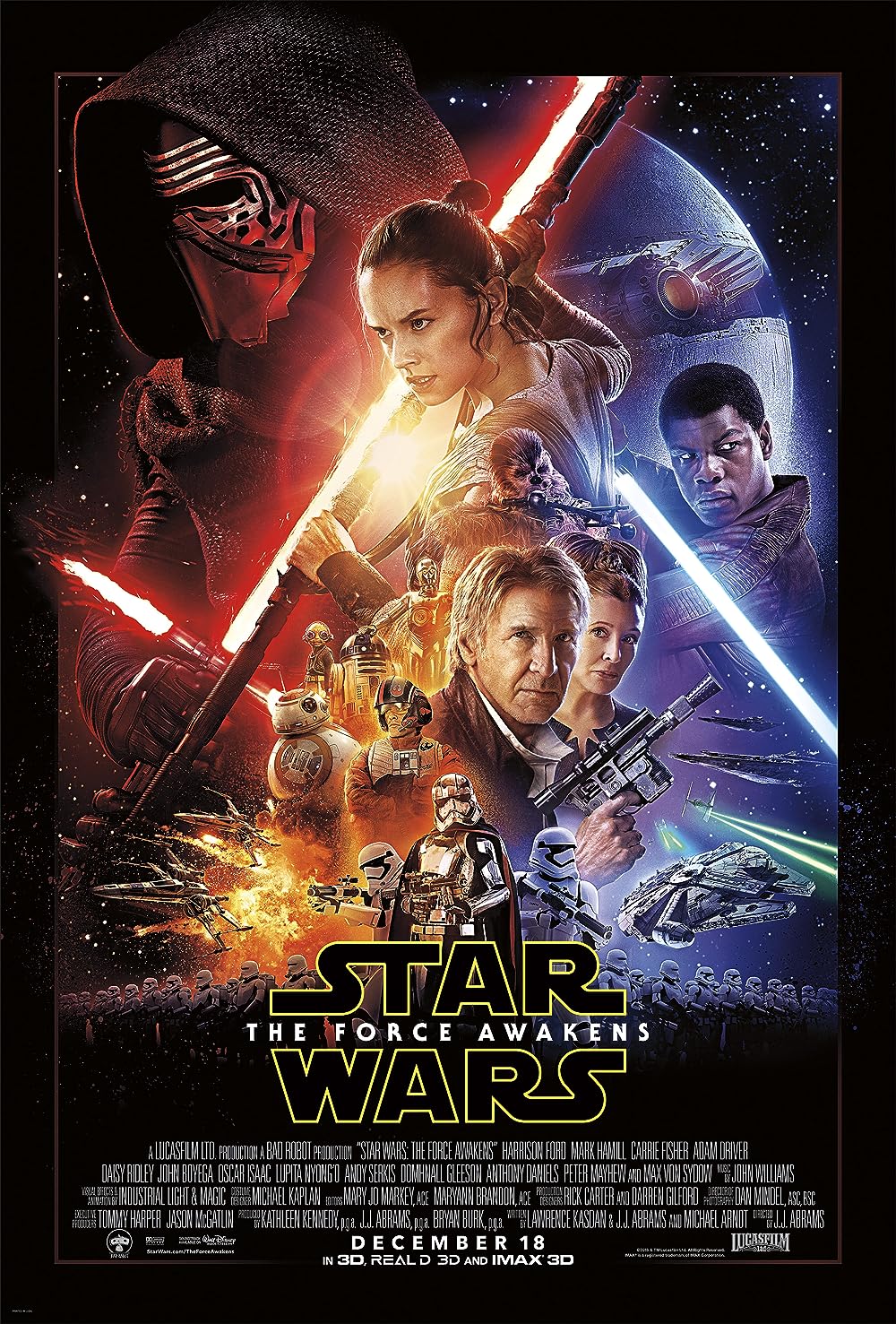
Thank You for Supporting Independent Film Criticism
If the work on DFR has added something meaningful to your love of movies, please consider supporting it.
Here are a few ways to show your support: make a one-time donation, join DFR’s Patreon for access to exclusive writing, or show your support in other ways.
Your contribution helps keep this site running independently. However you choose to support the site, please know that it’s appreciated.
Thank you for reading, and for making this work possible.
Brian Eggert | Critic, Founder
Deep Focus Review


